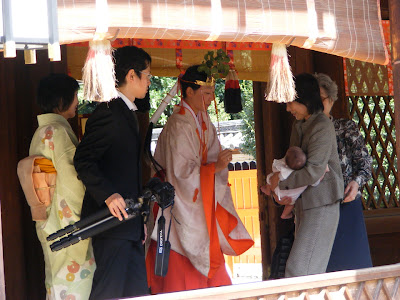We have also made a tour of many of the Shinto shrines in Kyoto, which in contrast to the fees charged by touristic Buddhist temples, have stayed true to their sacred calling and remain free.
We are here at to Kenkun jinja a quiet hill top shrine just to the south of Tani House, but have also visited Yoshida and Yasaka shrines and the very picturesque Shimogamo shrine set in a park between the two forks of the river which was literally pulsating with a series of wedding ceremonies, and 'christenings' of infants demonstrating the relationship between Shinto and the rights of passage of life in birth and marriage, and a ceremony between a Shinto priest and his partner wildly dressed up like a woman in a traditional Japanese medieval play almost unable to move for the flowing bulky garments, requiring two attendants to get her into her clogs to move to the next shrine.
Kyoto has a rich spread of Shinto shrines, in parks and on hilltops which we shall look at several of in this chapter.
In Kyoto I have discovered a golden rule. Never follow one religion. Either have none at all, or make sure to have two and give only some of your allegiance to each. In the case of Japan there is no one religion but an ebb and flow between Shinto's polarity of life, fertility and energy and Buddhism's pole of quiescence, chastity and death. By separating the two, each person remains free from the oppression either might deliver on its own and able to give spiritually in a way which one dominant religion rapidly obliterates - thus as I have mentioned Shinto serves birth, marriage, luck, worldly fertility and cultural continuity while Buddhism serves death, enlightenment and meditative repose.
Hence several of these shrines have the rites of passage of life and fertility, consecrating a newborn, and marriage, as well as some other rites and prayer offerings.

































At Shimogamo-jinja we witnessed several weddings and a couple in traditional costume undergoing a sacred ceremony.

Sounds of the sacred flutes at the shrine.





































 Kadode Hachiman Jinja
Kadode Hachiman JinjaThe Kadode Hachiman jinja was a little deserted shrine in west Kyoto with a charming little garden.






































0 件のコメント:
コメントを投稿